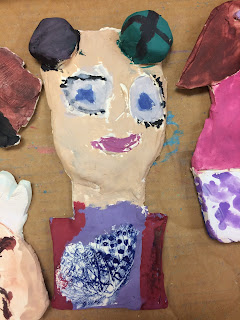With my fifth graders this year, I decided to look at some modern ceramic artists and found Christy Keeney and Liz Scrine--two working British artists. Go ahead and look them up, their work is ah-maze-ing! I also had some designer silkscreens from Mayco that I really wanted to try out (I like the bugs best, but my students liked them all).
Our first step was to design and build a slab person,
 |
| It's very obvious that she was inspired by Christy Keeney's work. |
 |
| This student has done NOTHING all year, ceramics may be 'his thing.' |
 |
| I do love this one! |
 |
| This is a special needs friend, and he did the BEST on his silkscreen. |
The process for this is pretty simple, you draw around the image and cut it out (larger than your outline). Then USE TAPE ('cause that wet-it-and-it-will-stick that it says on the directions totally does not work) to attach the silkscreen (smooth side down) onto the bisque fired clay. Next, mix a small amount of glaze (we used Stroke & Coat) with the silkscreen medium powder (it's about $4/container and I forgot I had some and ordered two more, so it's obvious that I now have enough for the next 150 years) and use your finger to smoosh it through the silkscreen. I did this at one table with small groups of students as they were working on another project, then put them immediately in the kiln for a second firing. When done correctly, the detail is awesome!
So, after they were all fired again, we used tempera block paint to paint them:
Here they are all done, dry and ready to go home:
 |
| Hard to see in this photo, but the spider is amazing! |
 |
| There is a silkscreen'ed ladybug under the rainbow. |
 |
| I just love this one, even though she missed silkscreening. |
 |
| Gotta have some rainbow hair! |
 |
| It's Hillary Clinton. Because of course it is. |





















